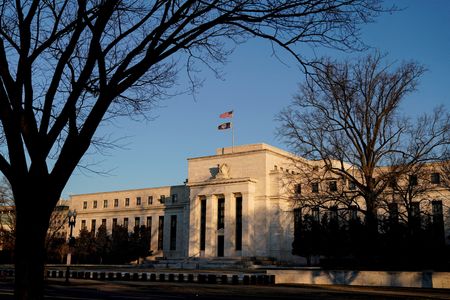By Michael S. Derby
NEW YORK (Reuters) – The Federal Reserve’s ongoing efforts to shrink its balance sheet may end earlier than once thought, even as the U.S. central bank charts a more aggressive path of interest rate rises.
Fed watchers reckon it will most likely have to stop in some form its current shedding of Treasury bonds and mortgage-backed securities (MBS) next year due to rising shortfalls of financial sector liquidity that may already be happening. Such shortfalls could threaten the central bank’s control over its overnight interest rate target, which is why it may have to react.
When it comes to officials’ comments on the balance sheet outlook, “it seems like they’re oddly silent about this whole thing at the moment,” said Derek Tang, economist with forecasting firm LH Meyer. He believes the Fed will start seeing signs of liquidity issues in the spring of 2023 and take action by June to start throttling the drawdown of its holdings.
Joseph Wang, chief investment officer at Monetary Macro, believes a process most refer to as quantitative tightening, or QT, will be changed in the third quarter of 2023. The shift, when it comes, “could be due to deteriorating Treasury market liquidity or continued decline in bank reserves,” he said.
Analysts at investment bank Nomura see the Fed ending the balance sheet run-off in September of next year. A New York survey conducted ahead of the November policy meeting found major banks are predicting the run-off to end in the final quarter of next year.
Goldman Sachs, however, forecasts the run-off will likely spill into late 2024 or even 2025 before the Fed changes gear, highlighting the uncertainty that still haunts this part of the central bank outlook.
The Fed has been shrinking its holdings of bonds since the summer as part of its broader effort to increase the cost of borrowing to help slow the economy and bring inflation down from the highest levels seen since the 1980s. While officials haven’t given an end date for this process, economists have assumed officials expected it to last for around a couple of years.
The main thrust of that effort rests on lifting short-term interest rates, which the Fed did again last week when it raised its overnight target rate range by half a percentage point to between 4.25% and 4.50%. It also penciled in a higher stopping point for that rate, at 5.1%, than it did at its September policy meeting.
The balance sheet drawdown, meanwhile, has been designed to run more or less on autopilot, in the background.
NO RETURN TO PRE-PANDEMIC BALANCE SHEET
Over the last decade and a half, the Fed has used its balance sheet twice as a tool of monetary policy to add or remove stimulus from the economy. The last major round of expansion kicked off in March 2020, at the outset of the coronavirus pandemic.
From the spring of that year, the Fed moved its holdings from $4.2 trillion to a peak of just shy of $9 trillion by April of this year, fueled by aggressive purchases of Treasury and mortgage bonds. The Fed began to raise rates in March and it started in June to allow a set number of bonds it owned to mature and not be replaced.
This process swung into full gear in September when the Fed said it would permit up to $60 billion a month in Treasury debt and $35 billion per month in MBS to fall off its balance sheet. As of Dec. 14, Fed holdings stood at about $8.6 trillion.
Nomura said the U.S. central bank will likely get its balance sheet down to around $7 trillion, well above the pre-pandemic level. Among analysts, there’s considerable debate about exactly how it might go about ending the drawdown.
Reductions in the Fed balance sheet withdraw bank reserves from the system, in a regime that’s dominated by many moving parts, swirling around each other unpredictably. But even with all that, a dearth of reserves makes short-term rates unstable, which means the Fed can’t reliably set its policy rate target.
It’s something the Fed faced in September 2019, when it was in its latest chapter of balance sheet contraction. At that time, it unexpectedly hit a shortage of reserves, unmooring the federal funds rate and forcing the central bank to start adding liquidity back into the system.
The Fed does not want a repeat of that experience and, as such, it is unlikely to test how far it can run down reserves.
On Nov. 30, Fed Chair Jerome Powell said he didn’t believe the banking system was running short on reserves, but he also suggested the central bank will manage its holdings in a way that could cause the drawdown to end sooner than once expected.
“Demand for reserves, it’s not stable, it can move up and down very substantially. So we want to stop at a place that’s safe,” he said. “It’s really a public benefit to have plenty of reserves, plenty of liquidity in the markets and in the banking system, in the financial system generally.”
(Reporting by Michael S. Derby; Editing by Dan Burns and Paul Simao)

